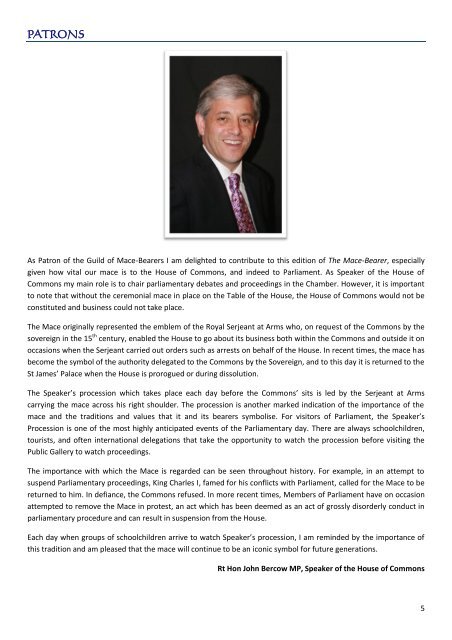The Mace-Bearer Magazine - Guild of Mace-Bearers
The Mace-Bearer Magazine - Guild of Mace-Bearers
The Mace-Bearer Magazine - Guild of Mace-Bearers
Create successful ePaper yourself
Turn your PDF publications into a flip-book with our unique Google optimized e-Paper software.
PATRONS<br />
As Patron <strong>of</strong> the <strong>Guild</strong> <strong>of</strong> <strong>Mace</strong>-<strong>Bearer</strong>s I am delighted to contribute to this edition <strong>of</strong> <strong>The</strong> <strong>Mace</strong>-<strong>Bearer</strong>, especially<br />
given how vital our mace is to the House <strong>of</strong> Commons, and indeed to Parliament. As Speaker <strong>of</strong> the House <strong>of</strong><br />
Commons my main role is to chair parliamentary debates and proceedings in the Chamber. However, it is important<br />
to note that without the ceremonial mace in place on the Table <strong>of</strong> the House, the House <strong>of</strong> Commons would not be<br />
constituted and business could not take place.<br />
<strong>The</strong> <strong>Mace</strong> originally represented the emblem <strong>of</strong> the Royal Serjeant at Arms who, on request <strong>of</strong> the Commons by the<br />
sovereign in the 15 th century, enabled the House to go about its business both within the Commons and outside it on<br />
occasions when the Serjeant carried out orders such as arrests on behalf <strong>of</strong> the House. In recent times, the mace has<br />
become the symbol <strong>of</strong> the authority delegated to the Commons by the Sovereign, and to this day it is returned to the<br />
St James’ Palace when the House is prorogued or during dissolution.<br />
<strong>The</strong> Speaker’s procession which takes place each day before the Commons’ sits is led by the Serjeant at Arms<br />
carrying the mace across his right shoulder. <strong>The</strong> procession is another marked indication <strong>of</strong> the importance <strong>of</strong> the<br />
mace and the traditions and values that it and its bearers symbolise. For visitors <strong>of</strong> Parliament, the Speaker’s<br />
Procession is one <strong>of</strong> the most highly anticipated events <strong>of</strong> the Parliamentary day. <strong>The</strong>re are always schoolchildren,<br />
tourists, and <strong>of</strong>ten international delegations that take the opportunity to watch the procession before visiting the<br />
Public Gallery to watch proceedings.<br />
<strong>The</strong> importance with which the <strong>Mace</strong> is regarded can be seen throughout history. For example, in an attempt to<br />
suspend Parliamentary proceedings, King Charles I, famed for his conflicts with Parliament, called for the <strong>Mace</strong> to be<br />
returned to him. In defiance, the Commons refused. In more recent times, Members <strong>of</strong> Parliament have on occasion<br />
attempted to remove the <strong>Mace</strong> in protest, an act which has been deemed as an act <strong>of</strong> grossly disorderly conduct in<br />
parliamentary procedure and can result in suspension from the House.<br />
Each day when groups <strong>of</strong> schoolchildren arrive to watch Speaker’s procession, I am reminded by the importance <strong>of</strong><br />
this tradition and am pleased that the mace will continue to be an iconic symbol for future generations.<br />
Rt Hon John Bercow MP, Speaker <strong>of</strong> the House <strong>of</strong> Commons<br />
5


